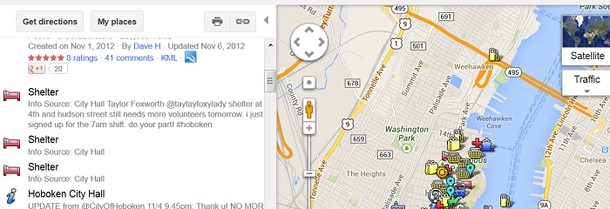Looking Back on Hurricane Sandy and the Tech Community, One Year Later

On the anniversary of the date Hurricane Sandy hit New Jersey, NJTechWeekly.com looks back on those hectic, powerless days following the storm.
For seven days, NJTechWeekly.com was, like our readers, without heat, communications and power. Cell towers near us were down, the Internet wouldn’t work without power, and for days we were unable to update the website.
When the fledgling New Jersey News Commons at Montclair State University opened its doors to all New Jersey reporters after Sandy hit, we were able to go in and use its resources to provide some timely updates on what was happening in the tech community.
Most of the stories we wrote weren’t pretty. They hadn’t been proofread or copyedited. But they told it like it was. The updates were very popular and, not surprisingly, were among our most- read pieces of 2012.
We covered efforts by the Jersey Shore Tech Meetup (Asbury Park) and the NJ Tech Meetup (Hoboken) to raise money for Sandy relief via crowdfunding on the Web.
The Asbury Park group whose “Restore the Shore” T-shirts and hoodies raised more than $130,000 in its community and the NJ Tech Meetup whose similar “Heal Hoboken” apparel raised $32,000 had jumped into action immediately after the storm hit and devastated their communities. Stevens students helped fulfill the Heal Hoboken orders. In both cases, a team effort was needed to make it happen.
Tech community members in droves offered to help each other out, showing the true meaning of the word community.
Hoboken tech community members who were on the NJ Tech Meetup mailing list and had power were able to get the word out via organizer Aaron Price and member Jeff Frommer that they were willing and able to lend a hand to other tech community members in need of a place to work or even a spare room for the family to sleep. Price, Frommer and others coordinated this, although they only had small pockets of power.
NJ Entrepreneurship and Tech Startup Meetup organizer Zion Kim took a page from the NJ Tech Meetup book and began a needs exchange list. He said: “Please share with us your area, what you need, or what you can offer, anything helps! (i.e. office space, a spare room for someone or a displaced family, food, drink, hugs, milk, power, high fives, again anything helps!)”
The coworking spaces—home to many in the startup community—were quick to get into the act as well. As soon as JuiceTank in Somerset got its power back, it offered free coworking to those in need. New Jersey’s Business Incubation Network put out a notice that many of its member incubators had room to temporarily house small companies that had been disrupted by flooding or other damage.
In Hoboken, Mission 50 owner Greg Dell’Aquila went out of his way to restore power and Internet to his coworking space in Hoboken. Once the water that surrounded the office building housing the coworking space had receded, he “did everything he could to get a generator.”
Working with Chris Ferreira of Send Tech, Dell’Aquila hooked the generator up to the power panel and restored power to the coworking space. Then he spent hours waiting in line, getting the gasoline to power the generator. By the Saturday after the storm, he was able to open up the space to everyone and get the word out to the tech community that they were welcome to work there. See the full Mission 50 story here.
The established tech companies, big and small, were also quick to jump in and help. Early on, Ridgefield Park-based Samsung Electronics North America pledged $3 million to the American Red Cross via ABC TV’s Day of Giving, with viewer donations matched by the company up to $3 million. The company also matched employee gifts.
T-Mobile in Parsippany provided phones and additional phone chargers to all American Red Cross shelters in New Jersey. Red Cross donations by the company and customers exceeded $300,000.
AT&T, which has a large presence in New Jersey, said it had contributed $1 million to Governor Christi’s Sandy Relief charity to help displaced victims from the shore, and much more. This contribution was in addition to a $100,000 contribution for the New Jersey Food Bank.
Cloud-computing powerhouse SHI (Somerset) said it would help organizations affected by Sandy get back on their feet by making free cloud-computing services available so public and private organizations could quickly and securely gain access to the applications or IT functions they might have lost in the storm.
Phone.com, a New Jersey startup now operating out of the NJIT Enterprise Development Center in Newark, offered VoIP and cloud-based telephone accounts for service for up to one year to as many as 100 small and medium-sized businesses in New Jersey that have been affected by Superstorm Sandy.
Synchronoss (Bridgewater) did its bit to help out and to reward its many employees who came to work “and performed flawlessly” during the emergency. The company devised a multipronged approach called Synchronoss Cares, and committed to donating up to $100,000 to kick off the program. It wanted its employees to be able to donate and raise money, give back as individuals and contribute work hours to the cause. See that story here.
NJTechWeekly.com is sure there were many more acts of charity by tech companies that we missed.
The hurricane spawned some new tech businesses and nonprofits out of necessity.
We learned about the efforts of healthcare executive and Hoboken resident David Haier, who, along with dedicated volunteers, created Hoboken Sandy Maps. The map website crowdsourced information from Twitter, Facebook, Google and other social media sources about what was happening in Hoboken during the crisis, providing information on where to find food, gas, shelter and electricity, among other staples. It was an amazing undertaking and one that many found “lifesaving.”
Gil Olsen, of JerseyShoreSight.com, stitched together detailed aerial maps of the Ortley Beach area so that people who had evacuated could see where the devastation took place and could find their homes, or what was left of their homes, on a map.
YouGiveGoods, a New Jersey startup that runs virtual food drives, saw its usage spike in the Sandy aftermath. The company geared up to handle it and took many trucks of food to affected areas.
For more reading about those turbulent days:
NJ Tech Community Pulls Together After Hurricane Sandy (Update 7)
NJ Tech Community Responds to Sandy (Update 8)
NJ Tech Community Responds to Sandy (Update 9)
NJ’s Data Centers Came through Sandy Relatively Unscathed, NJTC Panelists Say
NJ’s Data Centers Came through Sandy Relatively Unscathed, NJTC Panelists Say, Part 2
Employees of Holmdel-based Vonage Win $100,000 To Be Used for Sandy Relief
Emergency Responders Suffered Social Media Overload during Sandy, Says NJIT Prof
Developers Create Apps, Wikis, at April Jersey Shore “Comeback-A-Thon”
Spotlight on NJ Startups: YouGiveGoods’ Patrick O’Neill, Part 1
Spotlight on NJ Startups: YouGiveGoods’ Patrick O’Neill, Part 2
At NJTM, Zimmer Backs Grassroots MileMesh Initiative to Make Hoboken More Resilient

